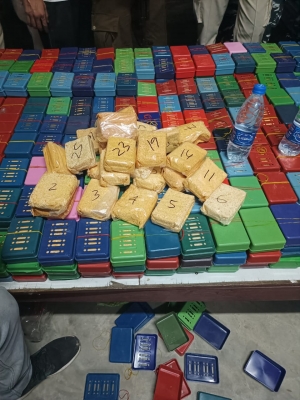By Shekhar SinghNew Delhi, Dec 17 : Proximity to two infamous narcotics domains — The Golden Triangle and the Golden Crescent — has been the biggest cause of India’s problem with drug trafficking.The country has seen a 70 per cent rise in consumption of narcotic substances in the last couple of years.
The Golden Triangle is the North-East border of India bordering Laos, Myanmar and Thailand which meet at the confluence of Mekong and Ruak.Myanmar holds the second spot after Afghanistan in illicit supply of morphine and heroin.
Myanmar produces 80 per cent of the world’s heroin and it is trafficked to the US, UK and China via Laos, Vietnam, Thailand and India mostly through sea routes.
Finance Minister Nirmala Sitharaman, in a written reply in the Rajya Sabha had said that a significant portion of drugs like heroin, cocaine and hashish are being smuggled into the country through the sea route.
The minister said as per inputs received from the Narcotics Control Bureau (NCB), the main drugs smuggled through the sea route are heroin, cocaine, hashish and Amphetamine Type Stimulants (ATS).
In the current year till November 30, of the 3,017 kg heroin seized, 55 per cent or 1,664 kg came through the sea route.
Of the 122 kg cocaine seized, 84 per cent or 103 kg was through the sea route.In the case of hashish and ATS seized till November this year, 23 per cent and 30 per cent were being smuggled through the sea route.
Several consignments of heroin seized in Guwahati and Dimapur have originated from the Golden Triangle.Myanmar’s heroin and meth enter India at two points, Moreh in Manipur and Champai in Mizoram.
However, interestingly, due to domestic security gaps, precursor chemicals including ephedrine, acetic anhydride and pseudo ephedrine are sourced from places in South India including Chennai and then transported to Kolkata and Guwahati via Delhi before being smuggled across the border to Myanmar.
According to the NCB’s latest annual report, drug trafficking through sea routes in the Arabian Sea and the Bay of Bengal, is estimated to account for around 70 per cent of the total illegal drugs smuggled into India.
As the drugs coming from sea routes pose a challenge for law enforcement agencies, experts say that the use of maritime routes by international drug syndicates based in Pakistan and Afghanistan is only expected to increase.
“Most of such seizures are sourced from the ports of Afghanistan and Iran, which are destined to coastal states in India or are in further transit to countries like Sri Lanka, Maldives, etc,” the NCB report stated.
Heroin is the most trafficked drug through the sea route, but ATS, marijuana, cocaine, etc.are also among the drugs seized, as per the report.
The NCB also seized 300 kg and 337 kg heroin from two Sri Lankan boats in March and April 2021.
However, in the largest haul, the Directorate of Revenue and Intelligence (DRI) has seized 3000 kg heroin from a consignment of talc in September 2021 at Mundra Port.Then 303 kg of cocaine was seized by the DRI officials in April 2021 at Tuticorin port and 205 kg of heroin from a consignment of Gypsum in April 2022 at Kandla Port.
“Apart from heroin, 2021-22 also witnessed two significant seizures of cocaine in containerised cargo emanating from Afghanistan-Iran.This trend indicates that drug syndicates and criminal organisations in the region are working with other international syndicates and criminal organisations to traffic drugs into India,” stated the recent annual DRI report.
“The magnitude and modus operandi of the cases clearly hint towards attempts by inimical elements to push narcotics into India and use proceeds of such smuggling to finance anti-national activities,” the DRI report claimed.
The Golden Crescent is a principal global site for opium production in Afghanistan, Iran, and Pakistan and then smuggling to India through Jammu and Kashmir, Punjab, Rajasthan and Gujarat.The drug smugglers have made potential markets and supply chain catalysts of hashish and heroin through these routes.
The syndicates through these bordering areas are now using new digital tools and the use of drones to smuggle the drugs.
However, nowadays, syndicates are also using couriers, parcels and postal services to smuggle drugs and deliver them.
The increased use of couriers or postal services is also directly linked to increased dark web activity in India.The quantity of drugs in parcels is usually a few grams to avoid suspicion and interception by law enforcement agencies.
In February this year, the NCB arrested 22 people, including software engineers, a financial analyst, an MBA and one of their own personnel.The accused were a pan-India drug trafficking network that was using the ‘darknet’ and cryptocurrency to courier narcotics at home.
Their arrest unearthed three major drug markets, DNM India, Dread and The Orient Express, running on the hidden web world after a four-month operation in Delhi-NCR, Gujarat, Maharashtra, Karnataka, Assam, Punjab, Jharkhand, West Bengal and Rajasthan.
They were delivering LSD (lysergic acid diethylamide) blots, psychotropic tablets, heroin, paste and liquid of cannabis, cocaine, Alprazolam tablets, charas, capsules of Spasomoproxyvon and imported ganja.
The recreational drugs by the gang were being sourced from countries like the US, UK, Netherlands and Poland using courier services and also the India Post network.
ssh/bg
#drugs #toes #Delhi #Chennai #Tamil #Kollywood # Nirmala Sitharaman #Sri #China # Assam #Guwahati #Delhi #New Delhi #Gujarat #Kandla #Jammu And Kashmir #Jammu #Jharkhand #Karnataka #Maharashtra #Manipur #Punjab #Rajasthan #Chennai #Tuticorin #West Bengal #Kolkata # Assam #Kolkata #Drones #Sitharaman
.






